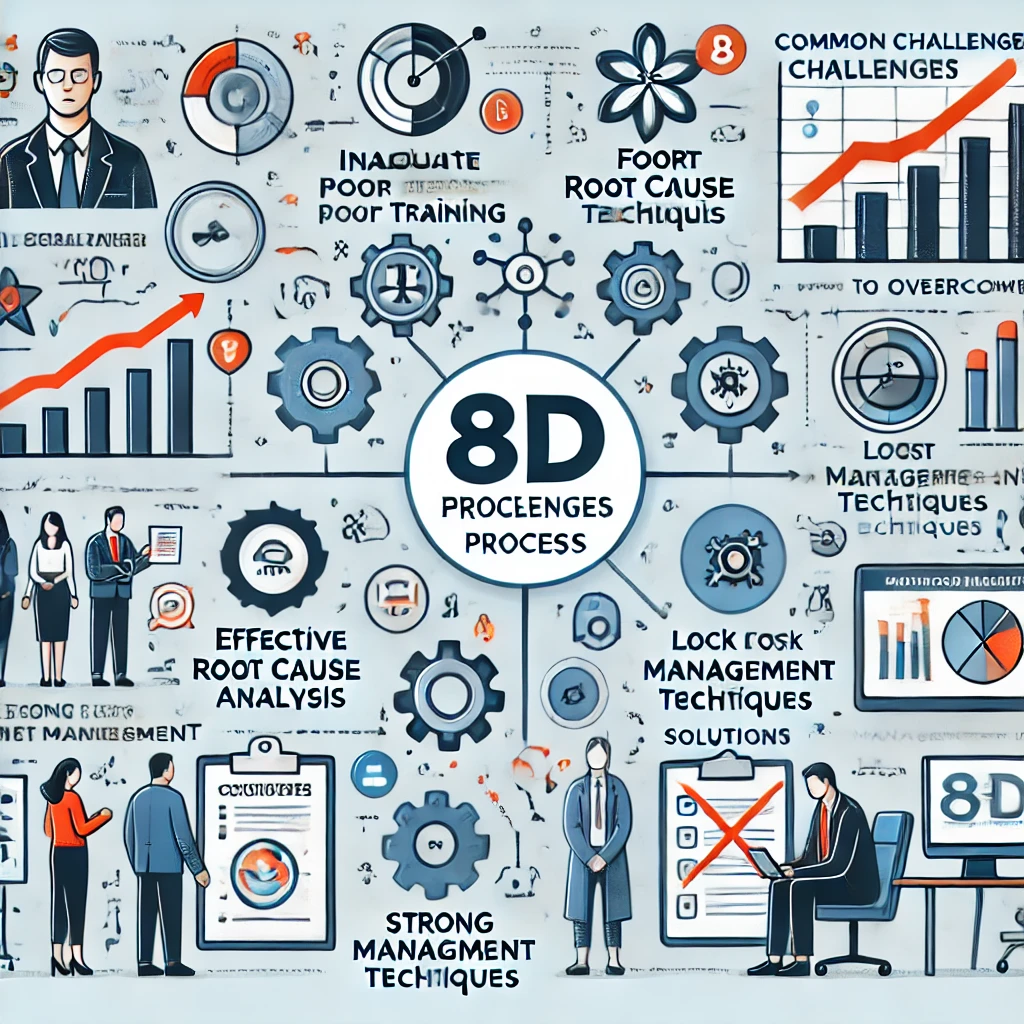The 8D (Eight Disciplines) process is a problem-solving methodology widely used in the manufacturing and automotive industries to identify, correct, and prevent recurring issues. Despite its effectiveness, organizations often encounter challenges when implementing the 8D process. This blog will explore common challenges in the 8D process and provide practical solutions for overcoming them.
1. Lack of Proper 8D Training
1.1 Importance of 8D Training
Effective implementation of the 8D process requires thorough understanding and expertise. Without proper 8D training, team members may struggle to apply the methodology correctly, leading to incomplete or ineffective solutions.
1.2 Implementing Comprehensive 8D Training Programs
To address this challenge, organizations should invest in comprehensive 8D training programs. These programs should cover the principles of the 8D process, the use of 8D root cause analysis tools, and practical case studies. Regular refresher courses can help maintain and update team members’ skills.
2. Inadequate 8D Management and Coordination
2.1 Challenges in 8D Management
Effective 8D management requires coordination and collaboration among various team members. Lack of clear roles, responsibilities, and communication can hinder the progress of the 8D process.
2.2 Enhancing 8D Management through Clear Roles and Communication
To overcome this, organizations should define clear roles and responsibilities for each stage of the 8D process. Establishing effective communication channels and regular progress meetings can ensure that all team members are aligned and working towards the same objectives.
3. Incomplete 8D Root Cause Analysis
3.1 The Importance of Thorough Root Cause Analysis
One of the critical steps in the 8D process is identifying the root cause of the problem. Incomplete or superficial root cause analysis can lead to temporary fixes rather than permanent solutions.
3.2 Utilizing Advanced Root Cause Analysis Tools
Organizations should leverage advanced root cause analysis tools and techniques, such as Fishbone Diagrams and the Five Whys, to ensure thorough investigation. Encouraging a culture of critical thinking and attention to detail can also enhance the effectiveness of root cause analysis.
4. Resistance to Change
4.1 Overcoming Organizational Resistance
Implementing the 8D process often requires changes in established practices and mindsets. Resistance to change from employees and management can impede the successful adoption of the 8D methodology.
4.2 Fostering a Culture of Continuous Improvement
To address resistance to change, organizations should foster a culture of continuous improvement. This involves promoting the benefits of the 8D process, providing adequate support and resources, and recognizing and rewarding successful implementation efforts.
5. Insufficient Documentation and Record-Keeping
5.1 Challenges with Documentation
Proper documentation is essential for tracking progress, facilitating communication, and ensuring accountability in the 8D process. However, many organizations struggle with maintaining accurate and comprehensive records.
5.2 Implementing an Effective eQMS
To overcome documentation challenges, organizations should implement an electronic Quality Management System (eQMS). An eQMS can streamline documentation processes, ensure data accuracy, and provide easy access to records for audits and reviews.
6. Inadequate Follow-Up and Verification
6.1 Importance of Follow-Up in the 8D Process
Ensuring that corrective actions are effective and that problems do not recur requires diligent follow-up and verification. Inadequate follow-up can result in unresolved issues and recurring defects.
6.2 Establishing Robust Follow-Up Mechanisms
Organizations should establish robust follow-up mechanisms to monitor the effectiveness of corrective actions. This can include regular audits, performance reviews, and feedback loops to ensure continuous improvement.
7. Integrating the 8D Process into Existing Systems
7.1 Challenges of Integration
Integrating the 8D process into existing Quality Management Systems can be challenging. Incompatibilities between different systems and processes can hinder seamless implementation.
7.2 Leveraging eQMS for Seamless Integration
To address integration challenges, organizations should leverage eQMS solutions that support the 8D process. An eQMS can provide a centralized platform for managing all quality-related activities, ensuring that the 8D process is integrated smoothly into the overall Quality Management framework.
8. Ensuring Sustained Commitment to the 8D Process
8.1 Maintaining Long-Term Commitment
Sustaining commitment to the 8D process requires continuous effort and engagement from all levels of the organization. Without ongoing support, initial enthusiasm can wane, leading to inconsistent application of the methodology.
8.2 Building a Culture of Quality and Accountability
Organizations should build a culture of quality and accountability to ensure sustained commitment to the 8D process. This involves setting clear expectations, providing ongoing support and resources, and promoting the value of the 8D methodology through success stories and tangible results.
Conclusion
In 2024, the complexity of quality management processes demands robust and integrated solutions. ComplianceQuest 8D Management offers a comprehensive suite of tools designed to support the 8D process, from root cause analysis to follow-up and verification. By leveraging ComplianceQuest, organizations can overcome common challenges in 8D management, streamline their quality management processes, and ensure sustained commitment to continuous improvement. Investing in ComplianceQuest 8D Management is essential for businesses aiming to maintain high standards of quality and achieve long-term success.
By addressing these common challenges and leveraging advanced technology, organizations can enhance their 8D process, leading to more effective problem-solving, improved product quality, and greater customer satisfaction.
